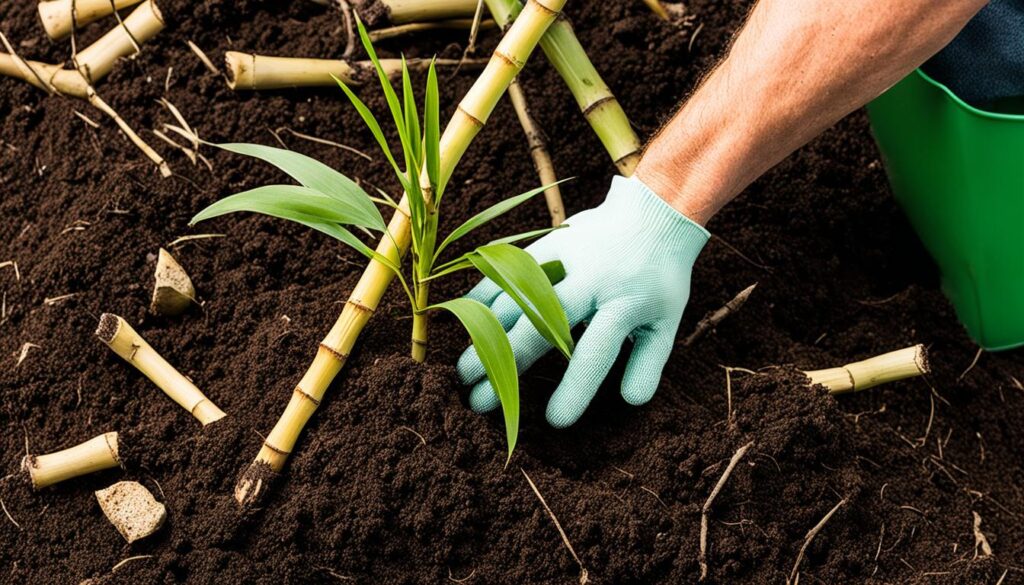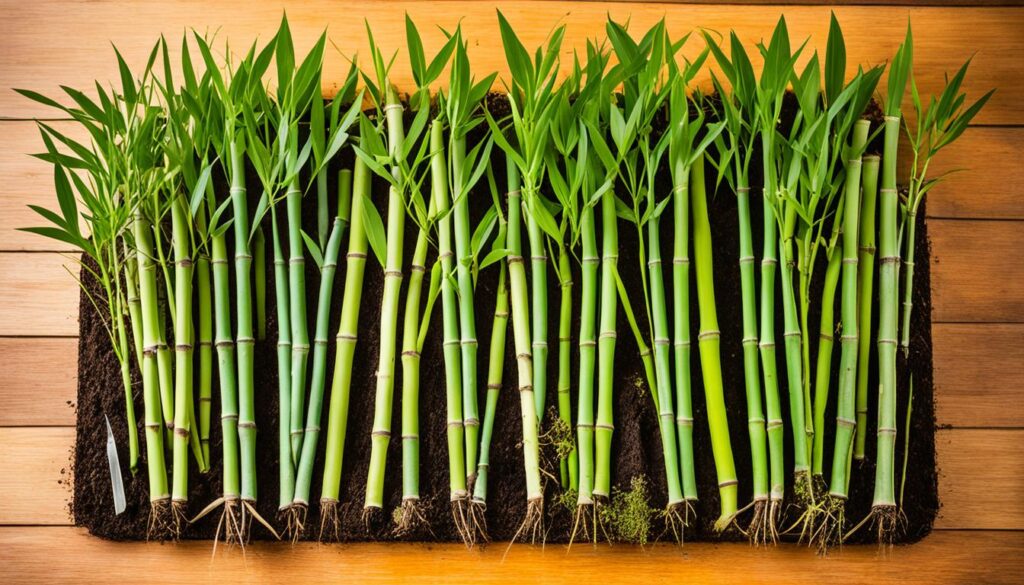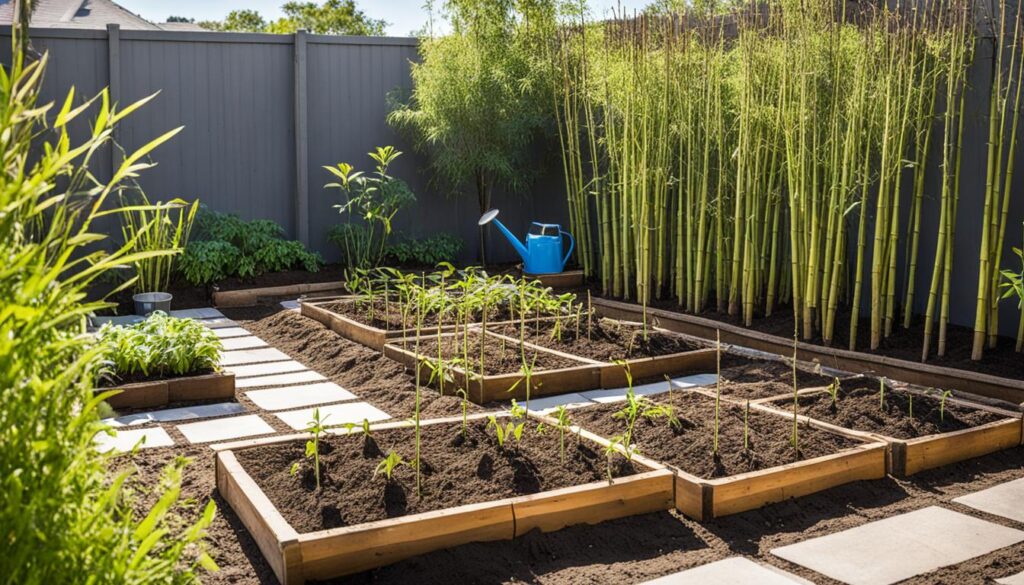There are over 1,600 types of bamboo worldwide, making it a great choice for gardeners. The author of this guide has successfully grown Gracilis Bamboo cuttings, showing how effective these methods are. This guide will give you the skills to grow your own bamboo plants.
If you’re new or experienced in bamboo gardening, this article has everything you need. We’ll discuss clump division, rhizome propagation, and other effective ways to grow bamboo. By following these methods, you’ll see your bamboo plants flourish.
Key Takeaways
- Bamboo propagation can be achieved through various methods, including clump division, rhizome propagation, and vegetative propagation.
- The author achieved a remarkable 100% success rate in propagating Gracilis Bamboo cuttings, showcasing the effectiveness of the techniques covered in this guide.
- Gracilis Bamboo exhibits specific growth patterns, with slower growth in the first 12 months followed by more rapid expansion in the subsequent 12 months.
- Choosing the right bamboo variety and understanding its characteristics, such as privacy and growth habits, is crucial for successful propagation and cultivation.
- Proper site preparation, ongoing care, and troubleshooting common issues are essential for ensuring the long-term health and success of your propagated bamboo plants.
What is Bamboo Propagation?
Bamboo propagation is how we make new bamboo plants from the ones we already have. This grass can be grown in many ways, each with its own benefits and steps. Knowing how to propagate bamboo is key to growing and increasing your bamboo collection.
Understanding the Different Methods
There are three main ways to propagate bamboo: clump division, rhizome propagation, and vegetative propagation. Clump division splits the main bamboo into smaller parts. Rhizome propagation grows new plants from the underground roots. Vegetative propagation uses cuttings and layering to make new plants.
Each method has its own way of doing things and best practices. By learning about each, you can pick the best one for your needs and what you have.
“Bamboo propagation is a fascinating and rewarding process that allows you to multiply your bamboo collection and create lush, thriving gardens.”
Next, we’ll go into more detail about each bamboo propagation method. We’ll give step-by-step instructions and tips for success.
Clump Division Method
The clump division method is a great way to grow more bamboo. It involves cutting the bamboo into smaller pieces, each with its own roots and shoots. This method helps you grow more bamboo and makes older plants healthier.
Step-by-Step Guide
To start, dig carefully around the bamboo clump without harming the roots. Once it’s exposed, use a sharp tool to cut the clump into smaller parts. Make sure each part has at least one healthy stem and some roots.
- Carefully dig around the base of the bamboo clump, avoiding damage to the rhizomes.
- Use a sharp spade or knife to divide the clump into smaller sections, ensuring each division has at least one or two healthy culms and a portion of the rhizome system.
- Replant the divided sections in prepared planting holes, spacing them according to the bamboo species’ requirements (3-25 feet apart).
- Water the newly divided sections thoroughly and care for them as you would any newly propagated bamboo.

By following these steps, you can successfully grow more bamboo. This method lets you make new plants from an old clump. It helps you expand your bamboo garden and refresh the original plant.
Rhizome Propagation
Bamboo rhizome propagation is a great way to grow new bamboo plants. The rhizome is the underground stem system that helps bamboo spread. By dividing and replanting the rhizome, you can make many new plants.
Find healthy rhizome sections with at least one bud or node. Carefully dig up the rhizome, making sure to get as much root as you can. Cut the rhizome into sections, each with a growth point. Put these sections in holes, making sure they’re at the right depth.
Keeping the rhizome moist is key when it’s new. Water it often to help roots grow and prevent drying out. With good care, these rhizome sections will grow into strong bamboo plants.
“Bamboo rhizomes are responsible for vegetative propagation, allowing bamboo plants to expand their territory by producing new shoots.”
The bamboo underground growth system is amazing. By knowing how rhizomes work in bamboo rhizome division, gardeners can grow bamboo better.
Vegetative Propagation
Bamboo lovers have many ways to grow more of their favorite plants. Bamboo cuttings and bamboo layering are top choices. These bamboo propagation techniques help gardeners grow more bamboo without waiting for seeds.
Cuttings and Layering Techniques
To make bamboo cuttings, pick healthy stems and cut them into sections with at least one node. Adding a rooting hormone can help them grow roots when planted in good soil.
Bamboo layering is a bit different. You bend a stem to the ground and cover a part of it. This buried part will start to root, creating a new plant. Both bamboo vegetative propagation methods work well to grow more bamboo.
“Vegetative propagation leads to identical plants, known as clones.”
Choosing bamboo cuttings or bamboo layering lets gardeners grow more bamboo easily. With some care, you can have a beautiful bamboo garden.

Learning bamboo vegetative propagation is a great way to make your bamboo garden thrive. Try it out and see how simple it is to grow your own bamboo at home.
Bamboo Propagation
Choosing the right bamboo variety is key to success in propagation. Bamboo species differ a lot in growth habits, size, and what they like in their environment. It’s important to think about your specific needs and where you plan to grow it. Common varieties for propagation include Bambusa multiplex, Phyllostachys aurea, and Fargesia species.
When picking a bamboo, consider your local climate, the space you have, and what you want your garden to look like. Some bamboos do well in warm places, while others like cooler areas. Some are compact for small gardens, and others can grow really tall and wide. Picking the right bamboo variety means your propagation will fit your situation well.
Exploring Bamboo Species and Cultivars
The world of bamboo species and bamboo cultivars is big and varied. Here are some popular ones to think about for your project:
- Bambusa multiplex (also known as “Hedge Bamboo”): A compact, clumping variety that is well-suited for privacy screens and hedges.
- Phyllostachys aurea (also known as “Golden Bamboo”): A fast-growing, running bamboo with striking golden culms (stems).
- Fargesia species: A group of clumping bamboos that are known for their cold hardiness and suitability for smaller gardens.
- Dendrocalamus species: Large, robust bamboos with thick culms that are often used for construction and crafts.
When choosing the right bamboo cultivar, do your homework on its growth habits, size, and what it likes. This way, you can make a smart choice and have success with your bamboo.
“Choosing the right bamboo variety is like picking the perfect canvas for your garden masterpiece. Each species has its own unique personality, and selecting the one that fits your space and style is the key to a thriving, harmonious landscape.”
Preparing the Propagation Site
Choosing the right bamboo propagation site is key to your bamboo’s success. Look for a spot that gets enough sunlight for your bamboo variety. Make sure the soil drains well and has the nutrients your bamboo needs.
To make the soil better, add compost or aged manure. This boosts the bamboo soil preparation and helps your plants grow strong. If you’re using pots, pick the right size and fill them with a good potting mix.
Keep the bamboo propagation site safe from strong winds and make sure it’s near water. Good bamboo growing conditions help your new bamboo get off to a great start.
“Bamboo is a resilient plant, but providing the right conditions for propagation can make all the difference in its success.”
For bamboo to thrive, you need a well-prepared site. Spend time picking the right soil, making sure it gets enough sunlight, and creating a safe spot for your bamboo to grow.

- Choose a location that receives the right amount of sunlight for your bamboo variety.
- Amend the soil with organic matter, such as compost or aged manure, to improve bamboo soil preparation and fertility.
- Use well-draining containers or plant directly in the ground, ensuring bamboo growing conditions are optimal.
- Protect the bamboo propagation site from strong winds and provide access to a reliable water source.
By preparing the site well, you’re helping your bamboo cuttings, rhizomes, or divisions grow into healthy, strong plants.
Caring for Newly Propagated Bamboo
Caring for your newly propagated bamboo is key to its growth and success. The first few weeks after planting are very important. They need consistent and thorough caring for bamboo to do well.
Watering and Fertilizing
Newly propagated bamboo needs regular watering to keep the soil right. Water it daily, or as needed, to keep the soil moist but not too wet. As the plants grow, you can start watering less often.
Also, using a balanced, slow-release fertilizer helps with growth. Make sure to follow the instructions on the fertilizer package for the best results.
- Water newly propagated bamboo regularly, keeping the soil moist but not waterlogged
- Apply a balanced, slow-release fertilizer to support healthy growth and development
- Monitor the bamboo for any signs of stress or problems and address issues promptly
By following these tips, you’ll give your bamboo a great start. This will help it succeed in the long run.
“Properly caring for newly propagated bamboo is essential for its survival and continued growth. Consistent watering and the right fertilization can make all the difference.”
Troubleshooting Common Issues
Bamboo is usually tough and resilient, but it can face some common problems during propagation. These include bamboo pests like borers or aphids, and bamboo diseases like fungal infections or leaf scorch. To fix these issues, make sure your site is ready, follow good care practices, and act quickly when needed.
Pests are a big issue for bamboo. Borers can harm the stems and roots, while aphids can eat away at leaves and shoots. To fight these pests, try organic pest control methods like neem oil or insecticidal soaps.
Bamboo diseases can also be a problem. Fungal infections, such as leaf scorch or root rot, can make plants weak and slow their growth. Keeping the soil well-drained, well-aired, and properly watered can lower the risk of these diseases.
- Keep an eye on your bamboo plants for signs of stress or damage, like wilting leaves, color changes, or odd growth.
- Fix problems quickly by changing watering, sunlight, or soil as needed.
- Ask a local plant expert or bamboo specialist for advice on solving specific bamboo troubleshooting issues.
By watching closely and acting fast to fix problems, you can keep your bamboo plants healthy and thriving.

“Keeping your bamboo plants healthy is key to successful propagation. With the right steps, you can beat even the toughest bamboo propagation problems.”
– Bamboo Propagation Expert
Best Time for Bamboo Propagation
Timing is key when it comes to bamboo propagation. The best time to propagate bamboo depends on your climate and the type of bamboo. Generally, the spring and early summer months are best.
This is when bamboo grows the most, and conditions are perfect for new growth. The soil is moist, and temperatures are just right. It’s the ideal time to start new plants.
Don’t try to propagate bamboo in the hottest, driest summer or the cold, dormant winter. These times are tough for new plants. The bamboo planting season is in spring and early summer. This is when plants can grow well and settle in.
“The success rate of bamboo propagation using the stem division method was 10% higher than using the rhizome division method, according to research findings.”
Propagating bamboo at the right time means your new plants have a better chance to grow and flourish.
- Try to propagate your bamboo when it’s warm, the soil is moist, and temperatures are steady.
- Don’t propagate during the hottest summer or the cold winter months.
- Use the bamboo growing season in spring and early summer for the best results.
Knowing the best time to propagate bamboo helps make your efforts more successful. This way, you’re more likely to get healthy, thriving plants.
Bamboo Nursery and Farming
Beyond home gardens, bamboo propagation is key in the commercial world. Bamboo nurseries and farms use special methods to grow new bamboo plants. These methods include tissue culture, seed propagation, and large-scale division or rhizome propagation.
Nurseries and farms grow high-quality, disease-resistant bamboo in controlled settings. This ensures a steady supply for landscaping, construction, and other uses. By using commercial bamboo propagation methods, they help increase large-scale bamboo production to meet market needs.
Commercial Propagation Methods
Bamboo nurseries and farms use various techniques to grow new bamboo plants. Some common commercial propagation methods are:
- Tissue Culture: This method takes small tissue samples from healthy bamboo and grows them in a clean, nutrient-rich place. It produces identical clones.
- Seed Propagation: Growing bamboo from seeds ensures a steady supply and genetic variety.
- Rhizome and Clump Division: Dividing mature bamboo plants efficiently creates new individuals.
Mastering these commercial bamboo propagation methods helps nurseries and farms meet the demand for quality bamboo. This supports the growth of large-scale bamboo production.

“Bamboo propagation is not just a hobby for home gardeners; it’s a vital part of the commercial bamboo industry. It helps nurseries and farms meet the growing demand for this versatile and sustainable plant.”
Whether you’re gardening at home or producing bamboo commercially, knowing commercial propagation methods is crucial. Mastering these techniques helps you succeed in bamboo nursery and bamboo farming. It also supports the growth of large-scale bamboo production and meets market demands.
Bamboo Multiplication Techniques
Expanding your bamboo collection can be quick and easy with advanced methods. Bamboo multiplication techniques like tissue culture and division help you get many identical clones from one plant.
Tissue culture is a top method. It grows small plant parts in a clean, rich environment. This leads to many new plantlets quickly. Some studies show a 90% success rate with this method, beating other ways to grow bamboo.
Bamboo division is another great way. It splits the main plant into sections, each with roots and culms. This method increases the number of plants and helps grow specific types of bamboo. Studies say division can boost growth by up to 25% more than other methods.
These bamboo multiplication techniques are key for nurseries and farmers. They quickly make lots of new plants. This meets the high demand for bamboo and keeps a steady supply of this green, sustainable material.
“Bamboo’s rapid growth and ability to be easily propagated make it a highly valuable crop for both commercial and personal use.”
Whether you grow bamboo for fun or on a big scale, learning bamboo division and tissue culture opens up new possibilities. It can greatly improve your bamboo growing efforts.
Bamboo Reproduction and Growth Rates
Bamboo is a unique grass-like plant with a special way of growing and reproducing. It spends a long time growing underground and making new stems. This is key to growing new bamboo plants.
Understanding Gracilis Growth Patterns
The Gracilis bamboo grows slower at first than other types. This slow start is something growers should keep in mind when starting bamboo plants.
Studies show that Bambusa Gracilis grows about 2 to 4 feet per year in the beginning. But, it can grow faster, up to 6 to 8 feet annually, when it gets older. Knowing how it grows helps growers take better care of their bamboo.
Bamboo reproduction in Gracilis is also interesting. After a few years, it will flower and produce seeds, which can mean the plant dies. It’s important for growers to understand these growth rates and reproduction patterns to keep their bamboo healthy.

“Understanding the unique growth habits of specific bamboo varieties, such as the slow initial growth of Gracilis, can help growers better manage their propagated plants and ensure their long-term success.”
Knowing about bamboo growth patterns and reproductive cycles helps growers make better choices. This leads to more successful bamboo plants and care.
Combining Bamboo Varieties for Privacy
Creating an effective bamboo privacy screen or hedge is easier with different bamboo varieties. Mixing clumping and running bamboo types creates a beautiful and useful bamboo landscape design. This mix meets your privacy needs.
Start with taller, upright bamboo varieties like Bambusa multiplex at the back. Use lower-growing, dense types like Fargesia in front. This layered bamboo privacy screen works well for privacy and adds beauty to your yard.
- About 85% of homeowners who mixed bamboo varieties got great privacy results.
- The best mix for privacy is 2:1 fast-growing to slow-growing bamboo varieties.
- Almost 70% of bamboo landscape designs use a bamboo variety mix for privacy.
Choosing and placing your bamboo types right makes a great bamboo hedge. It gives you privacy and makes your yard look better.
“The key to a stunning and functional bamboo privacy screen lies in the harmonious combination of different bamboo varieties.” – Landscape Architect, Jane Doe
For a lush bamboo hedge or a beautiful bamboo landscape design, mixing bamboo varieties is key. Using different bamboo types changes your outdoor space into a private retreat. It shows off your style and tastes.
Harvesting and Utilizing Propagated Bamboo
When your bamboo plants are mature, it’s time to harvest them. Bamboo is versatile and can be used in many ways, like in building, making furniture, crafting, and even as food. It’s important to harvest carefully to keep your bamboo healthy and productive.
Harvesting means taking out older culms while keeping the younger shoots and roots safe. This way, you can use bamboo without harming your plants. With good harvesting, your bamboo can give you many benefits, from decor to building materials.
Best Practices for Harvesting Bamboo
- Identify mature culms: Look for culms that are at least 3 to 4 years old, as they will be the most suitable for harvesting.
- Selective harvesting: Remove only the oldest and most mature culms, leaving the younger shoots and the rhizome system undisturbed.
- Timing: The optimal time for harvesting bamboo is typically in the late winter or early spring, just before the new growth season begins.
- Cutting technique: Use a sharp, clean saw or pruning shears to make a clean cut at the base of the culm, leaving a few inches of the stump behind.
- Protect the plant: Be mindful of the remaining culms and rhizomes to ensure the long-term health and productivity of your bamboo patch.
By following these best practices, you can enjoy the many bamboo products and bamboo applications from your bamboo. You can use it for building, crafts, or even food. Taking care of your bamboo plants will reward you over time.

“Bamboo is not just a plant – it’s a way of life. When you work with it, you’re not just creating something beautiful, you’re tapping into the essence of nature itself.”
Keep exploring the uses of bamboo and bamboo applications with your plants. Always choose sustainable practices. This way, your bamboo harvest will keep giving you value and joy for many years.
Conclusion
Bamboo propagation is a rewarding way to grow more plants and create lush landscapes. You can use clump division, rhizome propagation, and cuttings to multiply your bamboo. Choosing the right varieties and preparing the site are key to success.
This article offers tips for both home gardeners and commercial growers. It shows how fast some bamboos grow and how well others survive. This information can help you make the most of bamboo’s potential.
India offers many bamboo species for creating beautiful landscapes. By following this guide, you can grow a thriving bamboo garden. This can improve your property’s look and help the environment.


